Template:Header Common Functions
Introduction
The view management tool allows you to create and configure grids that are visible in the different managements of the database. For each created view, it is possible to determine the fields (last name, first name, telephone, address, etc.) visible in the grid. Each field is then represented as columns in order to allow you to search quickly on any field of the database, appearing in the grid.
It is possible to create as many views as desired in virtually all the managements of the software in order to use them subsequently. Moreover, if the network module is active in the software, it is also possible to manage the users who can see and use the created views.
In addition to choosing the fields (last name, first name, e-mail address, etc.) that must appear in the grid, this tool offers the possibility to apply a filter to a view. For instance, if you want to see only the people who are part of a precise category in the "Client management", or to only see the transactions linked to the "Golf" donation occasions in the "Analysis and history management".
It is also possible to determine which view that should appear by default when opening each management of the database ("Client management", "Tasks and history management", "Analysis and history", etc.
The view management tool is represented by the  button, that is always at the top, under the menu bar.
button, that is always at the top, under the menu bar.
Adding, Modifying and Deleting a View
|
The following examples are made from the "Client management", but the view management tool works in the same way in all managements.
After clicking on the  button, this menu opens. button, this menu opens.
|
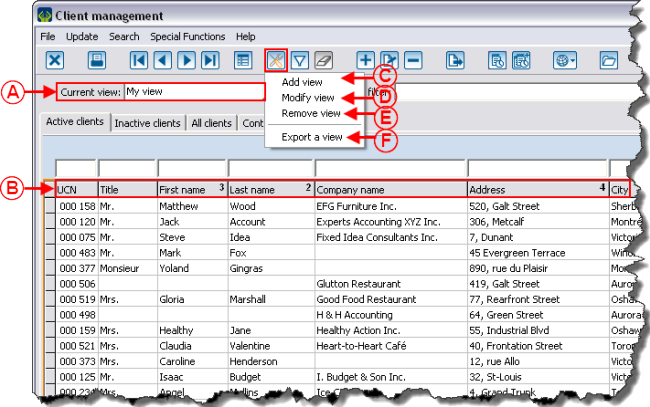
|
|
A: It is the name of the currently displayed view at B. To choose a different view, use the drop-down arrow.
NOTE: The view named "My view" is the default one in all the managements with the purchase of the software. It is possible to modify it, to rename it, but it is not possible to delete it.
|
B: Each column represents the fields chosen for the view selected at A.
|
|
C: Allows you to add a view that will be available at A. For more details concerning the addition of a view, see this section.
NOTE: The new view is based on the criteria of the view selected at A. This new view will therefore comprise the same fileds visible onscreen and the same specifications, but it will not be possible to modify them. It is therefore advantageous to first choose, at A, the view that contains the desired fields for more rapidity.
|
D: Allows you to modify the view selected at A. For more details concerning the modification of a view, see this section.
|
|
E: Allows you to delete the view selected at A. For more details concerning the deletion of a view, see this section.
|
F: Allows you to export a view in order to be able to import it in another database.
NOTE: This feature has been developed for organizations of the same type that have their own software, but who wished to have the same view configurations. The view are imported only in the same managements ("View management", "Analysis and history", etc.). By clicking on this option, the view is found in a file named "_Export".
|
Adding a View
To add a view, first go into the management in which a view has to be added.
NOTE: When a view is created in a management, it is only available in this management. The following example is done from the "Client management", but the view management tool  works in the same way in all the managements in which it is available.
works in the same way in all the managements in which it is available.
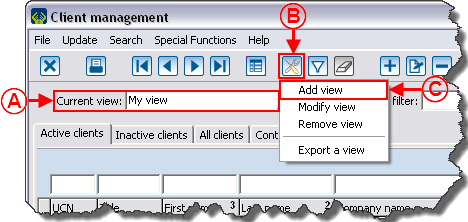
|
|
To add a view, once in the desired management, click on the  button at B, then select "Add view" at C. button at B, then select "Add view" at C.
NOTE: The new view is based on the criteria of the view selected at A. This new view will therefore comprise the fields visible onscreen and it will be possible to modify it. It is therefore advantageous to first choose, at A, a view that contains the desired fields for more rapidity.
|
|
After clicking on "add view", this window opens (it appears over another window)
|
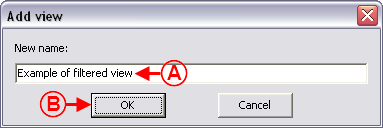
|
|
A: Name the view. It is important that can be easily memorized for further use of this new view.
|
B: After giving a name to the view, click on the "OK" button.
|
|
After clicking on the "OK" button of the window allowing to name the new view, this window appears onscreen.
|

|
|
A: It is the name of the view that is currently displayed in the management.
NOTE: The new view is based on the criteria of this view. The view will therefore comprise the fields visible onscreen and the same specifications, but it will not be possible to modify them.
|
B: It is the name of the created view.
|
See the "Configuring the View Using Tabs" section in order to configure the tabs "Columns", "Sort", "Filter", "Visibility".
Modifying a View
To modify a view, first go to the management in which the view must be modified.
NOTE: When a view is created, it is available only in this management.
The following example is done from the "Client management", but the view management tool  works in the same way in all managements in which it is available.
works in the same way in all managements in which it is available.
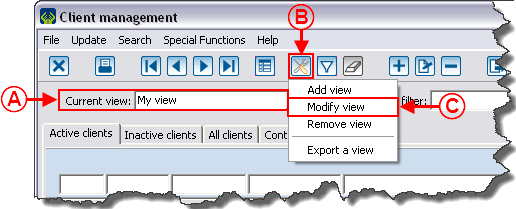
|
|
To modify a view, once in the management in which the view has been created, select the view to modify at A, click on the  button at B, then select "Modify view" at C. button at B, then select "Modify view" at C.
|
|
After clicking on "Modify view", this window opens.
|

|
|
A: It is the name of the currently displayed view in the management grid.
|
B: It is the name of the view that is currently being modified.
NOTE: It is possible to select another view to modify using the drop-down arrow on the right.
|
|
C: The  button allows you to add a new view at B. after clicking on the button allows you to add a new view at B. after clicking on the  button, this window opens in order to name the new view. button, this window opens in order to name the new view.
|
D: The button allows you to modify the name of the selected view at B. After clicking on the button, this window opens to rename the view.
|
|
E: The  button allows you to delete the selected view at B, For more details concerning view deletion, see this section. button allows you to delete the selected view at B, For more details concerning view deletion, see this section.
|
|
See the "Configuring the View Using Tabs" section to learn how to configure the tabs "Columns", "Sort", "Filter", and "Visibility".
Configuring the View Using Tabs
"Columns" Tab
This tab allows you to determine the fields that must be visible in the mangement grid. Each field is then represented in columns to allow quick search on any field of the database (Last name, first name, e-mail address, etc.), appearing in the grid.
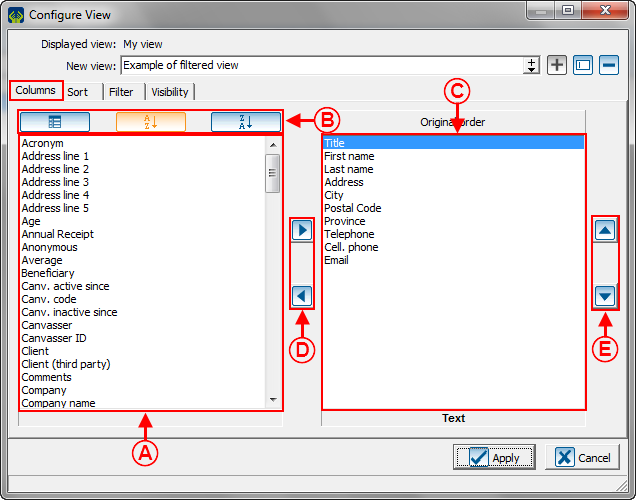
|
|
A: It is the list of all the fields available in the management whre the view has been created.
|
B: These buttons allow you to choose the order in which the fields at A should appear.
|
|
C: It is the list of fields that will appear when the view is displayed in the management. To see an overview of the order of the view fields, go to "Example of Filtered View in the Management Screen", see point B of the "Overview of a View in the Management" section.
|
D: The  buttons allow you to move the fields on the left (fields at A) to the right (fields at C) and vice-versa. To move a field from A to C, select a filed at A, then click on the button. To move a field from C to A, select a field at C, then click on the buttons allow you to move the fields on the left (fields at A) to the right (fields at C) and vice-versa. To move a field from A to C, select a filed at A, then click on the button. To move a field from C to A, select a field at C, then click on the  button. button.
|
|
E: The buttons allow you to modify the position of the columns in the management grid. To do so, select the fields to be moved at C, then click on the buttons to move the selected field upward or downward.
NOTE: The first field at the top will appear at the far left; this means that it is going to be the first column displayed in the management grid.
|
|
If the configuration of the view is completed, click on the " Apply" button.
Apply" button.
To carry on with the configuration using other tabs, see the sections ""Sort" Tab", ""Filter" Tab" and ""Visibility" Tab".
"Sort" Tab
This tab allows you to determine a sort order for the presentation of the view in the management grid. It is possible to choose on which field the sorting must be performed first, second, third, etc. as well as to choose to display the data in ascending or descending order.
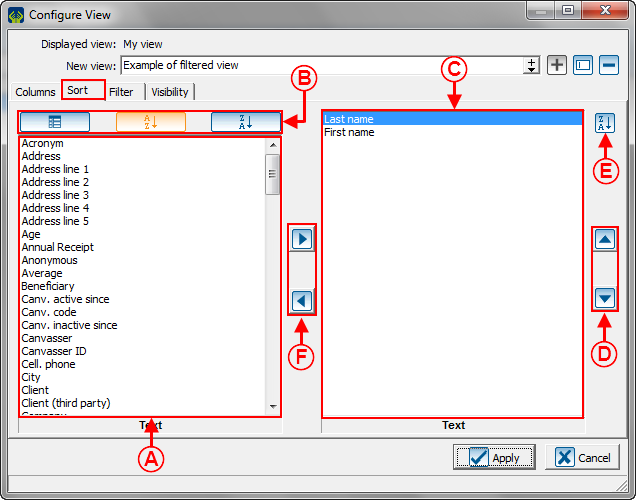
|
|
A: It is the list of all the fields available in the management where the view has been created.
|
B: These buttons allow you to choose the order in which the fields at A should appear.
|
|
C: These are the fields on which the sorting will be performed. In this example, the elements will be sorted by last names, and after by first names.
|
D: The buttons allow you to modify the position of the fields at C. To do so, select the field to be moved, then click on the buttons.
|
|
E: Allows you to choose if the information of the fields at C will be sorted by ascending or descending alphabetical order. If the field is sorted in descending alphabetical order, the statement "DESC" is added at the right of the field name at C. To sort a field in ascending order, select the field at C, then click on this button.
|
F: The  buttons allow you to move the fApply"ields on the left (fields at A) to the right (fields at C) and vice-versa. To move a field from A to C, select a field at A, then click on the button. To move a field from C to A, select a field at C, then click on the buttons allow you to move the fApply"ields on the left (fields at A) to the right (fields at C) and vice-versa. To move a field from A to C, select a field at A, then click on the button. To move a field from C to A, select a field at C, then click on the  button. button.
|
If the configuration of the view is completed, click on the " Apply" button.
Apply" button.
To carry on with the configurations using other tabs, see sections ""Columns" Tab", ""Filter" Tab" and ""Visibility" Tab".
"Filter" Tab
This tab allows you to apply a filter to the view.
|
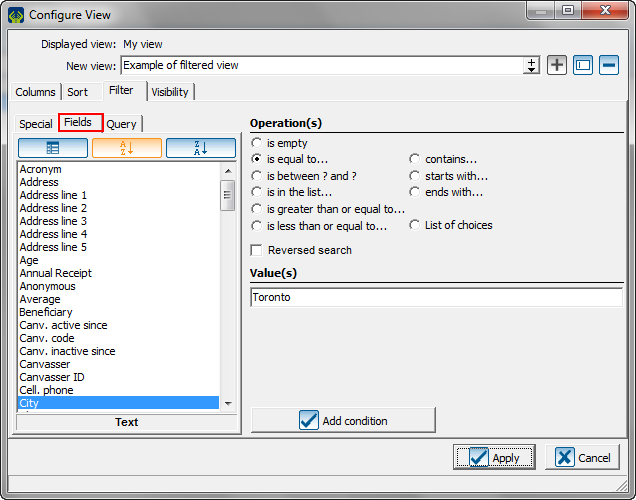
|
|
The "Filter" tab is configured in the exact same way as the addition of a filter in the management. To learn how to configure the tabs "Special", "Fields" and "Query", see the "Filter Data (Queries)" document. In this example, only the entries containing the value "Toronto" will be displayed in the management.
NOTE: When a filter is applied to a view, a filter icon appears next to the name of the view in the management. To view an example of a filtered view icon, see point A of the "Overview of the View in the Management" section.
|
If the configuration of the view is completed, click on the " Apply" button.
Apply" button.
To carry on with the configurations using other tabs, ""Columns" Tab", ""Sort" Tab", and ""Visibility" Tab".
"Visibility" Tab
This tab is visible only if the "Network Module" is activated in the software. It allows you to specify which users of the database can see, use or modify the view.
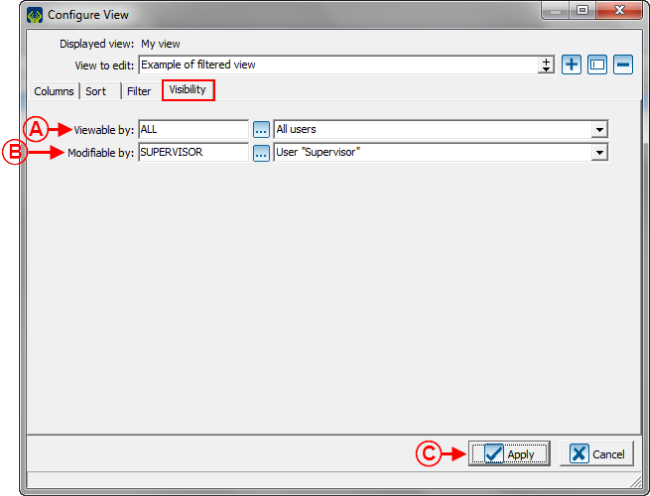
|
|
A: Allows you to choose which users can see and use the view. In this example, all the users of the database are able to see and use this view.
|
B: Allows you to choose the users who will be able to modify the view. In this example, only the user "Supervisor" can modify this view.
|
|
C: After configuring all the desired options of the view and the "Columns", "Sort", "Filter" and "Visibility" tabs, click on the " Apply" button to confirm the addition of the view or to confirm the modifications done to the view. Apply" button to confirm the addition of the view or to confirm the modifications done to the view.
|
|
Preview of the View in the Management
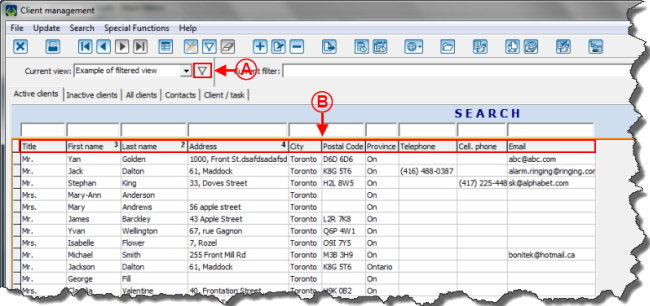
|
|
A: It is the icon that indicates that the current view is filtered.
|
B: These are the fields chosen in the "Columns" tab.
|
Deleting a View
To delete a view, first go to the management in which a view has to be deleted.
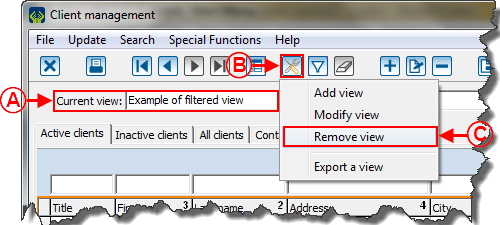
|
|
Once in the desired management, select the view to delete at A, using the drop-down arrow on the right, click on the  button at B, then select "Remove view" at C. button at B, then select "Remove view" at C.
|
|
After clicking on "Remove view", this window opens.
|

|
|
Click on the " Yes" button to confirm the deletion. Yes" button to confirm the deletion.
NOTE: By clicking on " Yes", the view will no longer be available for future use. Yes", the view will no longer be available for future use.
|
Selecting a Default View
Document name: Common functions:View Management
![]() button, that is always at the top, under the menu bar.
button, that is always at the top, under the menu bar.
![]() works in the same way in all the managements in which it is available.
works in the same way in all the managements in which it is available.
![]() works in the same way in all managements in which it is available.
works in the same way in all managements in which it is available.

![]() Apply" button.
Apply" button.
![]() Apply" button.
Apply" button.
![]() Apply" button.
Apply" button.











